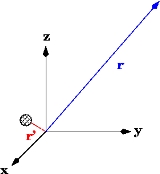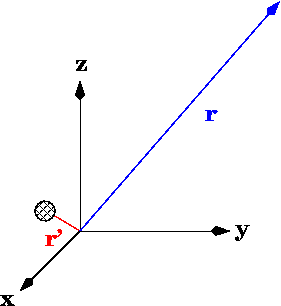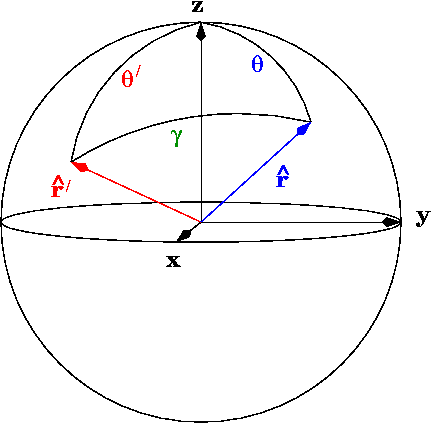
Spherical multipole moments
Encyclopedia
Spherical multipole moments are the coefficients in a series expansion
of a potential
that varies inversely with the distance R to a source, i.e., as 1/R. Examples of such potentials are the electric potential
, the magnetic potential
and the gravitational potential.
For clarity, we illustrate the expansion for a point charge, then
generalize to an arbitrary charge
density . Through this article,
. Through this article,
the primed coordinates such as
refer to the position of charge(s), whereas
the unprimed coordinates such as refer
refer
to the point at which the potential is being observed. We also
use spherical coordinates throughout, e.g., the vector
 has coordinates
has coordinates

where is the radius,
is the radius,
 is the colatitude
is the colatitude
and
 is the azimuthal angle.
is the azimuthal angle.
 The electric potential
The electric potential
due to a point charge located at
 is given by
is given by

where

is the distance between the charge position and the observation point
and is the angle between the vectors
is the angle between the vectors  and
and  .
.
If the radius of the observation point is greater than the radius
of the observation point is greater than the radius  of the charge,
of the charge,
we may factor out 1/r and expand the square root in powers of using Legendre polynomials
using Legendre polynomials

This is exactly analogous to the axial
multipole expansion
.
We may express in terms of the coordinates
in terms of the coordinates
of the observation point and charge position using the
spherical law of cosines
(Fig. 2)

 Substituting this equation for
Substituting this equation for  into
into
the Legendre polynomials and factoring the primed and unprimed
coordinates yields the important formula known as the spherical harmonic addition theorem

where the functions are the spherical harmonics
functions are the spherical harmonics
.
Substitution of this formula into the potential yields

which can be written as

where the multipole moments are defined
 .
.
As with axial multipole moments
, we may also consider
the case when
the radius of the observation point is less
of the observation point is less
than the radius of the charge.
of the charge.
In that case, we may write

which can be written as

where the interior spherical multipole moments are defined as the complex conjugate of irregular solid harmonics

The two cases can be subsumed in a single expression if
 and
and  are defined
are defined
to be the lesser and greater, respectively, of the two
radii and
and  ; the
; the
potential of a point charge then takes the form, which is sometimes referred to as Laplace expansion


with an infinitesimal charge element
and integrating. The functional form of the expansion is the same

where the general multipole moments are defined


with the interior multipole moments defined as

but concentric charge distributions can be derived. Let the
first charge distribution
be centered on the origin and lie entirely within the second charge
distribution . The interaction energy between any two static charge distributions is defined by
. The interaction energy between any two static charge distributions is defined by

The potential
of the first (central) charge distribution
may be expanded in exterior multipoles

where represents the
represents the 
exterior multipole moment of the first charge distribution.
Substitution of this expansion yields the formula

Since the integral equals the complex conjugate
of the interior multipole moments of the
of the
second (peripheral) charge distribution, the energy
formula reduces to the simple form

For example, this formula may be used to determine the electrostatic
interaction energies of the atomic nucleus with its surrounding
electronic orbitals. Conversely, given the interaction energies
and the interior multipole moments of the electronic orbitals,
one may find the exterior multipole moments (and, hence, shape)
of the atomic nucleus.
distribution is axially symmetric (i.e., is independent of the azimuthal angle ).
).
By carrying out the integrations that
integrations that
define and
and  , it can be shown the
, it can be shown the
multipole moments are all zero except when . Using the
. Using the
mathematical identity

the exterior multipole expansion becomes

where the axially symmetric multipole moments are defined

In the limit that the charge is confined to the -axis,
-axis,
we recover the exterior axial multipole moments
.
Similarly the interior multipole expansion becomes

where the axially symmetric interior multipole moments are defined

In the limit that the charge is confined to the -axis,
-axis,
we recover the interior axial multipole moments
.
Series expansion
In mathematics, a series expansion is a method for calculating a function that cannot be expressed by just elementary operators . The resulting so-called series often can be limited to a finite number of terms, thus yielding an approximation of the function...
of a potential
Potential
*In linguistics, the potential mood*The mathematical study of potentials is known as potential theory; it is the study of harmonic functions on manifolds...
that varies inversely with the distance R to a source, i.e., as 1/R. Examples of such potentials are the electric potential
Electric potential
In classical electromagnetism, the electric potential at a point within a defined space is equal to the electric potential energy at that location divided by the charge there...
, the magnetic potential
Magnetic potential
The term magnetic potential can be used for either of two quantities in classical electromagnetism: the magnetic vector potential, A, and the magnetic scalar potential, ψ...
and the gravitational potential.
For clarity, we illustrate the expansion for a point charge, then
generalize to an arbitrary charge
density
 . Through this article,
. Through this article,the primed coordinates such as

refer to the position of charge(s), whereas
the unprimed coordinates such as
 refer
referto the point at which the potential is being observed. We also
use spherical coordinates throughout, e.g., the vector
 has coordinates
has coordinates
where
 is the radius,
is the radius, is the colatitude
is the colatitudeColatitude
In spherical coordinates, colatitude is the complementary angle of the latitude, i.e. the difference between 90° and the latitude.-Astronomical use:The colatitude is useful in astronomy because it refers to the zenith distance of the celestial poles...
and
 is the azimuthal angle.
is the azimuthal angle.Spherical multipole moments of a point charge

Electric potential
In classical electromagnetism, the electric potential at a point within a defined space is equal to the electric potential energy at that location divided by the charge there...
due to a point charge located at
 is given by
is given by
where

is the distance between the charge position and the observation point
and
 is the angle between the vectors
is the angle between the vectors  and
and  .
.If the radius
 of the observation point is greater than the radius
of the observation point is greater than the radius  of the charge,
of the charge,we may factor out 1/r and expand the square root in powers of
 using Legendre polynomials
using Legendre polynomials
This is exactly analogous to the axial
multipole expansion
Axial multipole moments
Axial multipole moments are a series expansionof the electric potential of acharge distribution localized close tothe origin along oneCartesian axis,denoted here as the z-axis...
.
We may express
 in terms of the coordinates
in terms of the coordinatesof the observation point and charge position using the
spherical law of cosines
Law of cosines (spherical)
In spherical trigonometry, the law of cosines is a theorem relating the sides and angles of spherical triangles, analogous to the ordinary law of cosines from plane trigonometry....
(Fig. 2)


 into
intothe Legendre polynomials and factoring the primed and unprimed
coordinates yields the important formula known as the spherical harmonic addition theorem

where the
 functions are the spherical harmonics
functions are the spherical harmonicsSpherical harmonics
In mathematics, spherical harmonics are the angular portion of a set of solutions to Laplace's equation. Represented in a system of spherical coordinates, Laplace's spherical harmonics Y_\ell^m are a specific set of spherical harmonics that forms an orthogonal system, first introduced by Pierre...
.
Substitution of this formula into the potential yields

which can be written as

where the multipole moments are defined
 .
.As with axial multipole moments
Axial multipole moments
Axial multipole moments are a series expansionof the electric potential of acharge distribution localized close tothe origin along oneCartesian axis,denoted here as the z-axis...
, we may also consider
the case when
the radius
 of the observation point is less
of the observation point is lessthan the radius
 of the charge.
of the charge.In that case, we may write

which can be written as

where the interior spherical multipole moments are defined as the complex conjugate of irregular solid harmonics

The two cases can be subsumed in a single expression if
 and
and  are defined
are definedto be the lesser and greater, respectively, of the two
radii
 and
and  ; the
; thepotential of a point charge then takes the form, which is sometimes referred to as Laplace expansion
Laplace expansion (potential)
In physics, the Laplace expansion of a 1/r - type potential is applied to expand Newton's gravitational potential or Coulomb's electrostatic potential. In quantum mechanical calculations on atoms the expansion is used in the evaluation of integrals of the interelectronic repulsion.The Laplace...

General spherical multipole moments
It is straightforward to generalize these formulae by replacing the point charge
with an infinitesimal charge element

and integrating. The functional form of the expansion is the same

where the general multipole moments are defined

Note
The potential Φ(r) is real, so that the complex conjugate of the expansion is equally valid. Taking of the complex conjugate leads to a definition of the multipole moment which is proportional to Ylm, not to its complex conjugate. This is a common convention, see molecular multipoles for more on this.Interior spherical multipole moments
Similarly, the interior multipole expansion has the same functional form
with the interior multipole moments defined as

Interaction energies of spherical multipoles
A simple formula for the interaction energy of two non-overlappingbut concentric charge distributions can be derived. Let the
first charge distribution

be centered on the origin and lie entirely within the second charge
distribution
 . The interaction energy between any two static charge distributions is defined by
. The interaction energy between any two static charge distributions is defined by
The potential

of the first (central) charge distribution
may be expanded in exterior multipoles

where
 represents the
represents the 
exterior multipole moment of the first charge distribution.
Substitution of this expansion yields the formula

Since the integral equals the complex conjugate
of the interior multipole moments
 of the
of thesecond (peripheral) charge distribution, the energy
formula reduces to the simple form

For example, this formula may be used to determine the electrostatic
interaction energies of the atomic nucleus with its surrounding
electronic orbitals. Conversely, given the interaction energies
and the interior multipole moments of the electronic orbitals,
one may find the exterior multipole moments (and, hence, shape)
of the atomic nucleus.
Special case of axial symmetry
The spherical multipole expansion takes a simple form if the chargedistribution is axially symmetric (i.e., is independent of the azimuthal angle
 ).
).By carrying out the
 integrations that
integrations thatdefine
 and
and  , it can be shown the
, it can be shown themultipole moments are all zero except when
 . Using the
. Using themathematical identity

the exterior multipole expansion becomes

where the axially symmetric multipole moments are defined

In the limit that the charge is confined to the
 -axis,
-axis,we recover the exterior axial multipole moments
Axial multipole moments
Axial multipole moments are a series expansionof the electric potential of acharge distribution localized close tothe origin along oneCartesian axis,denoted here as the z-axis...
.
Similarly the interior multipole expansion becomes

where the axially symmetric interior multipole moments are defined

In the limit that the charge is confined to the
 -axis,
-axis,we recover the interior axial multipole moments
Axial multipole moments
Axial multipole moments are a series expansionof the electric potential of acharge distribution localized close tothe origin along oneCartesian axis,denoted here as the z-axis...
.
See also
- Solid harmonics
- Laplace expansionLaplace expansion (potential)In physics, the Laplace expansion of a 1/r - type potential is applied to expand Newton's gravitational potential or Coulomb's electrostatic potential. In quantum mechanical calculations on atoms the expansion is used in the evaluation of integrals of the interelectronic repulsion.The Laplace...
- Multipole momentsMultipole momentsIn mathematics, especially as applied to physics, multipole moments are the coefficients of a series expansion of a potential due to continuous or discrete sources . A multipole moment usually involves powers of the distance to the origin, as well as some angular dependence...
- Multipole expansionMultipole expansionA multipole expansion is a mathematical series representing a function that depends on angles — usually the two angles on a sphere. These series are useful because they can often be truncated, meaning that only the first few terms need to be retained for a good approximation to the original...
- Legendre polynomials
- Axial multipole momentsAxial multipole momentsAxial multipole moments are a series expansionof the electric potential of acharge distribution localized close tothe origin along oneCartesian axis,denoted here as the z-axis...
- Cylindrical multipole momentsCylindrical multipole momentsCylindrical multipole moments are the coefficients in a series expansion of a potential that varies logarithmically with the distance to a source, i.e., as \ln \ R...

